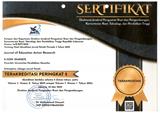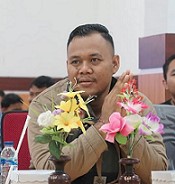The Effect of Visual Auditory, Kinesthetic Learning Styles on Students' Learning Interest at Christian Junior High School
DOI:
https://doi.org/10.23887/ijerr.v6i2.66319Keywords:
learning styles, visual, auditory, kinesthetic, learning interestAbstract
The problem that is often found in students is the difficulty of students in accepting subject matter which is effected by the learning style that students have. Student learning styles encourage students to gain interest and better learning outcomes. This study aimed to analyze the effect of visual, auditory, and kinesthetic learning styles on the learning interest of Christian Junior School students. This type of research was quantitative research. The sample in this study comprised all students of Christian Junior High School from grades VII and VIII, totaling 61 students. The data collection method was a survey using a questionnaire. Data were analyzed using multiple linear regression analysis using SPSS 20 software. The results showed that the visual, auditory, and kinesthetic learning styles had an effect on students' interest in learning at Christian Junior High School. In addition, the results of the study also found that kinesthetic learning style was a student learning style that had the most significant effect on student learning interest at 84,3%. In conclusion, the research findings indicate that students' learning interest is significantly affected by their learning styles. Individuals who are familiar with their learning styles can take essential steps to learn faster and more easily, resulting in desired learning outcomes.
References
Alhadabi, A., Aldhafri, S., Alkharusi, H., Al-Harthy, I., Alrajhi, M., & AlBarashdi, H. (2019). Modelling parenting styles, moral intelligence, academic self-efficacy and learning motivation among adolescents in grades 7–11. Sia Pacific Journal of Education, 39(1), 133–153. https://doi.org/10.1080/02188791.2019.1575795.
Anggrawan, A. (2019). Analisis Deskriptif Hasil Belajar Pembelajaran Tatap Muka dan Pembelajaran Online Menurut Gaya Belajar Mahasiswa. MATRIK : Jurnal Manajemen, Teknik Informatika Dan Rekayasa Komputer, 18(2), 339–346. https://doi.org/10.30812/matrik.v18i2.411.
Arikunto. (2012). Prosedur Penelitian Suatu Pendekatan Praktik. Remaja Rosdakarya.
Azmi, N. (2015). Model Pembelajaran Inside Outside Circle (Ioc)) Untuk Meningkatkan Hasil Belajar Siswa Dalam Proses Pembelajaran. Al Ibtida: Jurnal Pendidikan Guru MI, 2(1). https://doi.org/10.24235/al.ibtida.snj.v2i1.180.
Baker, D., Unni, R., Kerr-Sims, S., & Marquis, G. (2020). Understanding factors that influence attitude and preference for hybrid course formats. E-Journal of Business Education & Scholarship of Teaching, 14(1), 174–188. https://files.eric.ed.gov/fulltext.
Bire, A. L., Geradus, U., & Bire, J. (2014). Pengaruh Gaya Belajar Visual, Auditorial, Dan Kinestetik Terhadap Prestasi Belajar Siswa. Jurnal Kependidikan, 44(2). https://doi.org/10.21831/jk.v44i2.5307.
Chetty, N. D. S., Handayani, L., Sahabudin, N. A., Ali, Z., Hamzah, N., Rahman, N. S. A., & Kasim, S. (2019). Learning styles and teaching styles determine students’ academic performances. International Journal of Evaluation and Research in Education, 8(4), 610–615. https://doi.org/10.11591/ijere.v8i3. 20345.
Commodari, E., & La Rosa, V. L. (2021). General academic anxiety and math anxiety in primary school. The impact of math anxiety on calculation skills. Acta Psychologica, 220, 103413. https://doi.org/10.1016/j.actpsy.2021.103413.
Dewi, E. R., & Alam, A. A. (2020). Transformation Model for Character Education of Students. Cypriot Journal of Educational Sciences, 15(5), 1228–1237. https://doi.org/10.18844/CJES.V15I5.5155.
Djaali. (2013). Psikologi Pendidikan. Bumi Askara.
Ernawati, M. D. W., Asrial, A., Kurniawan, D. A., Pratama, W. A., & Perdana, R. (2021). Attitudes and Self-Efficacy: Perspectives on Science Subjects for Junior High School Students. Jurnal Pendidikan Dan Pengajaran, 54(3), 456–466. https://doi.org/10.23887/jpp.v54i3.36416.
Hartanto, W. (2016). Penggunaan E-Learning sebagai Media Pembelajaran. Jurnal Pendidikan Ekonomi, 10(1), 1–18. http://jurnal.unej.ac.id/index.php/JPE/article/view/3438.
Kartikasari, E., & Nuryasana, E. (2022). School literacy movement program in elementary school, Indonesia: Literature review. Journal of Education and Learning (EduLearn), 16(3), 336–341. https://doi.org/10.11591/edulearn.v16i3.20383.
Laakso, N. L., Korhonen, T. S., & Hakkarainen, K. P. J. (2021). Developing students’ digital competences through collaborative game design. Computers and Education, 174(August), 104308. https://doi.org/10.1016/j.compedu.2021.104308.
Lai, C.-S., Au, K.-M., & Low, C.-S. (2021). Beyond Conventional Classroom Learning: Linking Emotions and Self-Efficacy to Academic Achievement and Satisfaction with Online Learning during the COVID-19 Pandemic. Journal of Education and E-Learning Research, 8(4). https://doi.org/10.20448/journal.509.2021.84.367.374.
Leasa, M., Corebima, A. D., & Batlolona, J. R. (2020). The effect of learning styles on the critical thinking skills in natural science learning of elementary school students. Elementary Education Online, 19(4), 2086–2097. https://doi.org/10.17051/ilkonline.2020.763449.
Londa, A. H. (2018). Penggunaan Media Puzzle untuk Meningkatkan Hasil Belajar Peserta Didik pada Pembelajaran IPA. Journal of Elementary School (JOES), 1(2), 113–120. https://doi.org/10.31539/joes.v1i2.359.
Manuaba, G. N. G., & Putra, D. K. N. S. (2021). Learning Video Based on Contextual Approach Science Content of Grade V Elementary School. Indonesian Journal Of Educational Research and Review, 4(2), 178. https://doi.org/10.23887/ijerr.v4i2.39432.
Marzuki, Asih, E. C. M., & Wahyudin. (2019). Creative thinking ability based on learning styles reviewed from mathematical communication skills. Journal of Physics: Conference Series, 1315(1). https://doi.org/10.1088/1742-6596/1315/1/012066.
Nurmayani, N. (Nurmayani), Syuaib, M. Z. (Muhammad), & ‘Ardhuha, J. (Jannatin). (2016). Pengaruh Gaya Belajar VAK Pada Penerapan Model Pembelajaran Problem Based Learning Terhadap Hasil Belajar IPA Fisika Siswa SMP Negeri 2 Narmada Tahun Ajaran 2015/2016. Jurnal Pendidikan Fisika Dan Teknologi, 2(1), 13–21. https://doi.org/10.29303/JPFT.V2I1.283.
Oktari, S. W., Atmaja, H. T., & Rc, A. R. (2019). The Interaction of Learning Model and Learning Style in Improving Students Learning Outcomes. Journal of Primary Education, 8(5), 206–216. https://journal.unnes.ac.id/sju/index.php/jpe/article/view/32148.
Porter, B. De, & Hernacki, M. (2016). Quantum Learning Membiasakan Belajar Nyaman dan Menyenangkan. Kaifa Learning.
Putri Ningrat, S., Tegeh, I. M., & Sumantri, M. (2018). Kontribusi Gaya Belajar Dan Motivasi Belajar Terhadap Hasil Belajar Bahasa Indonesia. Jurnal Ilmiah Sekolah Dasar, 2(3), 257. https://doi.org/10.23887/jisd.v2i3.16140
Putri, R. N., Hidayah, N., & Mujidin. (2021). Penyesuaian Diri, Dukungan Sosial, dan Gaya Belajar Visual : Kontribusi terhadap Stres Akademik Siswa di Masa Pandemi. Psyche 165 Journal, 14(4), 339–345. https://doi.org/10.35134/jpsy165.v14i4.136.
Ramdan, A. Y., & Fauziah, P. Y. (2019). Peran orang tua dan guru dalam mengembangkan nilai-nilai karakter anak usia sekolah dasar. Premiere Educandum : Jurnal Pendidikan Dasar Dan Pembelajaran, 9(2). https://doi.org/10.25273/pe.v9i2.4501.
Rands, V. F., S., H., Gerrits, R., & Jensen, M. (2021). Implementing Guided Inquiry Active Learning in an Online Synchronous Classroom and its Impact on Test Question Performance. HAPS Educator, 25(2), 6–12. https://doi.org/10.21692/haps.2021.015.
Ritonga, N. C., & Rahma, I. F. (2021). Analisis gaya belajar VAK pada pembelajaran daring terhadap minat belajar siswa. Jurnal Analisa, 7(1), 76–86. https://doi.org/10.15575/ja.v7i1.11878.
Sriklaub, K., & Wongwanich, S. (2014). Learning activities aimed at promoting students’ interest: Synthesis of master teachers’ activity organizing methods via TV media. Procedia - Social and Behavioral Sciences, 116, 3375–3380. https://doi.org/10.1016/j.sbspro.2014.01.767.
Sudimahayasa, N. (2015). Penerapan Model Pembelajaran Tgt Untuk Meningkatkan Hasil Belajar, Partisipasi, Dan Sikap Siswa. Jurnal Pendidikan Dan Pengajaran, 48(1-3 SE-Articles). https://doi.org/10.23887/jppundiksha.v48i1-3.6917.
Sugiyono. (2014). Metode Penelitian Pendidikan Pendekatan Kuantitatif, Kualitatif, dan R&D. Alfabeta.
Sumarsono, S., & Firanti, A. (2021). Identification of Informatics Engineering Student Learning Styles in the Independent Learning Era. Jurnal Pendidikan Dan Pengajaran, 54(2), 306. https://doi.org/10.23887/jpp.v54i2.28672.
Suparman. (2016). Gaya Mengajar yang Menyenangkan Siswa. Pinus Book Publisher.
Takenaka, H., & Soga, M. (2019). Development of a support system for reviewing and learning historical events by active simulation using AR markers. Procedia Computer Science, 159, 2355–2363. https://doi.org/10.1016/j.procs.2019.09.410.
Taufan, M. Y. (2022). Professional Development of Teachers, Competencies, Educational Facilities and Infrastructure on Teacher Performance and Learning Achievement of High School Students in Makassar City. Golden Ratio of Social Science and Education, 2(1), 24–38. https://doi.org/10.52970/grsse.v2i1.168.
Uddiniyah, N., & Silfia, E. (2019). An analysis of students’ motivation in learning English at SMAN 8 Kota Jambi academic year 2018/2019. Journal Of English Language Teaching, 3(2), 139–149. http://jelt.unbari.ac.id/index.php/jelt/article/view/42.
Walet, J. (2011). Differentiating for Struggling Readers and Writers: Improving Motivation and Metacognition through Multisensory Methods & Explicit Strategy Instruction. Journal of the American Academy of Special Education Professionals, 83–91. https://eric.ed.gov/?id=EJ1137150.
Winarno, A., Fedin, M. Y. A., & Salleh, N. H. M. (2022). the Effect of Technological Literacy, Learning Facility, and Family Environment on Students’ Learning Motivation. Jurnal Pendidikan: Teori, Penelitian, Dan Pengembangan, 7(7), 246. https://doi.org/10.17977/jptpp.v7i7.15404.
Yeo, M. M. L. (2021). Social media and social networking applications for teaching and learning. European Journal of Science and Mathematics Education, 2(1), 53–62. https://doi.org/10.30935/scimath/9400.
Downloads
Published
How to Cite
Issue
Section
License
Copyright (c) 2023 Rinto Alexandro, Nani Setiawati, Susmita Irene, Orbit Thomas, Kharisma Nugraha Putra

This work is licensed under a Creative Commons Attribution-ShareAlike 4.0 International License.
Authors who publish with the Indonesian Journal of Educational Research and Review (IJERR) agree to the following terms:
- Authors retain copyright and grant the journal the right of first publication with the work simultaneously licensed under a Creative Commons Attribution License (CC BY-SA 4.0) that allows others to share the work with an acknowledgment of the work's authorship and initial publication in this journal.
- Authors are able to enter into separate, additional contractual arrangements for the non-exclusive distribution of the journal's published version of the work (e.g., post it to an institutional repository or publish it in a book), with an acknowledgment of its initial publication in this journal.
- Authors are permitted and encouraged to post their work online (e.g., in institutional repositories or on their website) prior to and during the submission process, as it can lead to productive exchanges, as well as earlier and greater citation of published work. (See The Effect of Open Access)












